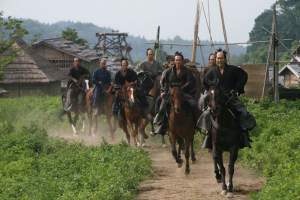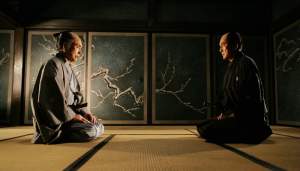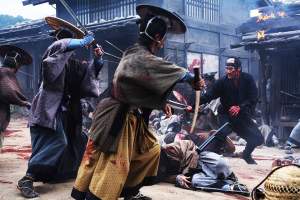In general, when we think of martial arts films it is usually the Hong Kong kung fu movies that first spring to mind, usually involving the likes of Bruce Lee and Jackie Chan knocking two shades out of all and sundry with nothing more than their bare hands and feet. Over the decades, as more of mainland Asia demanded their own localised chop-socky movies, new disciplines were introduced to the big screen, some were hybridised and most of them adopted wire-fu techniques to make them even more spectacular.
Japan also has a long history of martial arts, being the birthplace of karate. It also has a long and bloody history of feudal wars that relied more on the swords of the samurai than on empty hands. These epic tales have proved a rich source for storytellers over the centuries and in the twentieth century these entered popular culture through their portrayals in manga and on the cinema screen. Without a doubt the most famous of these movies is THE SEVEN SAMURAI by Akira Kurosawa, which brought many imitators, including Hollywood, which turned it into the classic western The Magnificent Seven. The 1963 black-and-white film THIRTEEN ASSASSINS followed a similar storyline to THE SEVEN SAMURAI, being about a group of samurai defending a village, and has now been remade by the prolific Takashi Miike, best known for his leftfield movies such as ICHI THE KILLER and SUKIYAKI WESTERN DJANGO.
Considering Miike's back catalogue, this is a faithful remake of an epic, based on a true historical event, with a linear story of honour and revenge. It still has the occasional surreal moment and some humour, but for the most part it is about the disparate group of samurai whose traditional role has been usurped by peace. However, this peace is short-lived with the arrival of the crazy, power-hungry Lord Naritsugu, who indiscriminately rapes and kills for his own amusement. Elderly, esteemed samurai Shimada is called upon to kill the ruthless leader before he can establish himself into a place of real authority, as well as for the honour of his victims. Shimada gathers together his band of warriors and they head off to the most strategic position they can find to ambush Naritsugu and his retinue.
Most of the first two acts are spent setting up the story and establishing the honour code of the samurai in preparation for the spectacular finale. While the film should have reminded me of the classics of Japanese cinema, and it did initially, the all-important fight sequence brought to mind the more contemporary cinema of Korean Kim Jee-Woon's THE GOOD, THE BAD AND THE WEIRD and, dare I say it, Zack Snyder's 300. However, the latter comparison was more to do with the odds than cinematic style. Miike's 13 ASSASSINS was far more visceral and believable than 300, thanks to the direction and the shooting style.
While we are lamenting the endless remakes coming out of Hollywood, this one remains faithful to the spirit of the original but updates it with improvements in shooting techniques, fight choreography and a superb cast. Undoubtedly we will see a rash of samurai films in its wake, but 13 ASSASSINS will still stand above them all.
13 ASSASSINS is in cinemas from May 6.


